Islamophobia and Its Impact on Muslims: A Study
VerifiedAdded on 2022/11/14
|10
|2515
|176
AI Summary
This paper sheds light on the views and experiences experienced by Muslims and the impact of Islamophobia on Muslims. It also analyses factors whether Islamic veils will be seen as a symbol of female obedience.
Contribute Materials
Your contribution can guide someone’s learning journey. Share your
documents today.
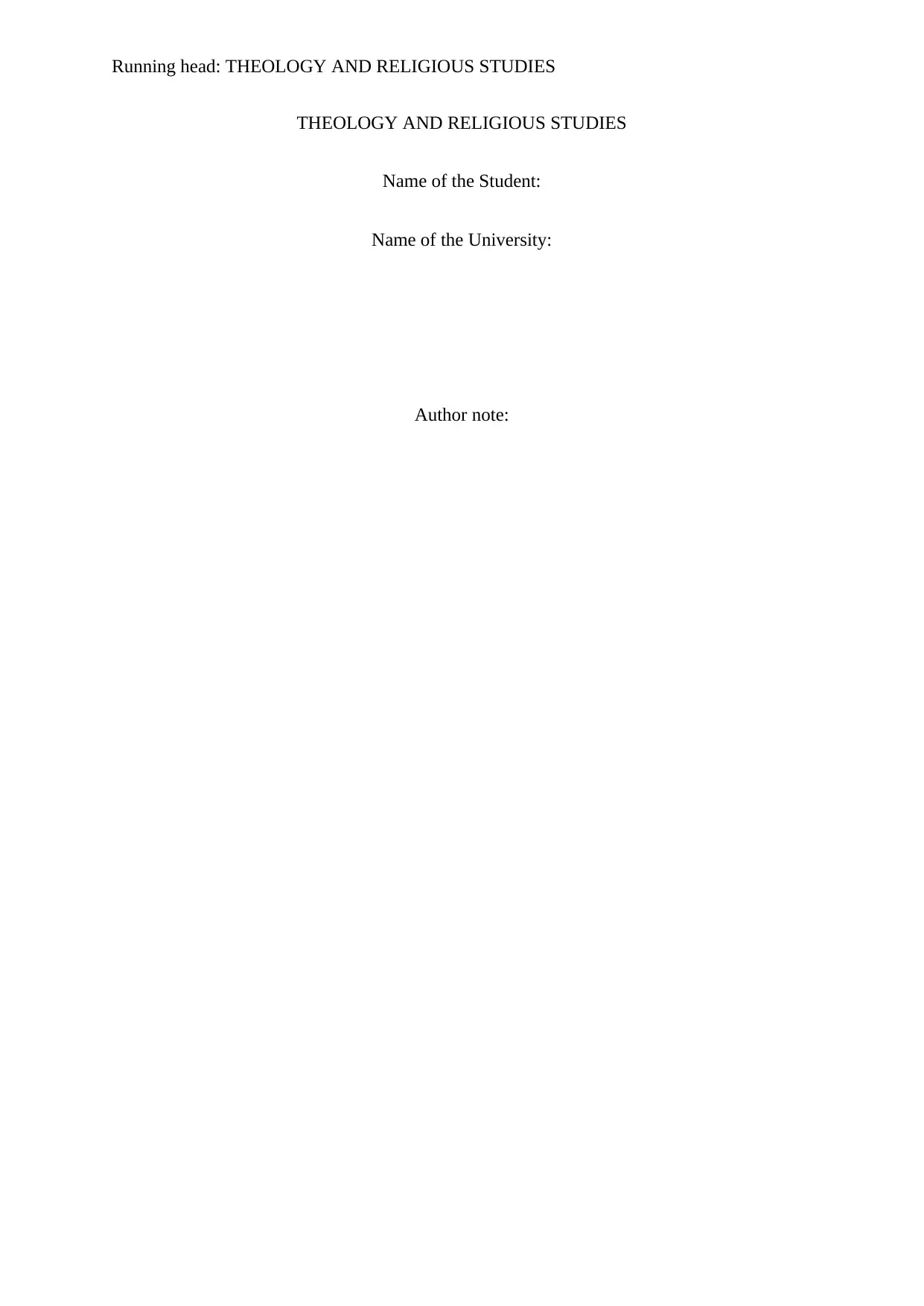
Running head: THEOLOGY AND RELIGIOUS STUDIES
THEOLOGY AND RELIGIOUS STUDIES
Name of the Student:
Name of the University:
Author note:
THEOLOGY AND RELIGIOUS STUDIES
Name of the Student:
Name of the University:
Author note:
Secure Best Marks with AI Grader
Need help grading? Try our AI Grader for instant feedback on your assignments.
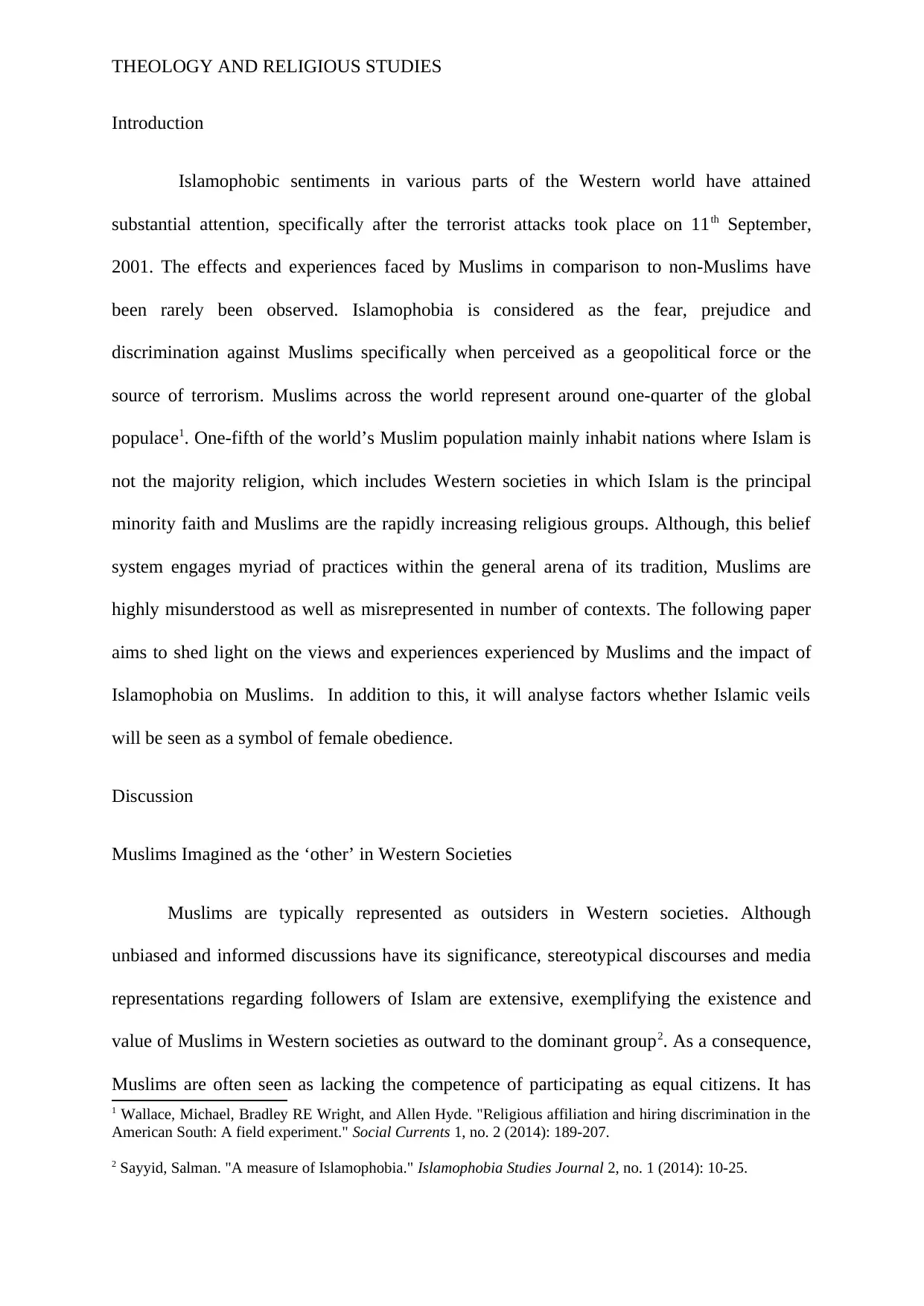
THEOLOGY AND RELIGIOUS STUDIES
Introduction
Islamophobic sentiments in various parts of the Western world have attained
substantial attention, specifically after the terrorist attacks took place on 11th September,
2001. The effects and experiences faced by Muslims in comparison to non-Muslims have
been rarely been observed. Islamophobia is considered as the fear, prejudice and
discrimination against Muslims specifically when perceived as a geopolitical force or the
source of terrorism. Muslims across the world represent around one-quarter of the global
populace1. One-fifth of the world’s Muslim population mainly inhabit nations where Islam is
not the majority religion, which includes Western societies in which Islam is the principal
minority faith and Muslims are the rapidly increasing religious groups. Although, this belief
system engages myriad of practices within the general arena of its tradition, Muslims are
highly misunderstood as well as misrepresented in number of contexts. The following paper
aims to shed light on the views and experiences experienced by Muslims and the impact of
Islamophobia on Muslims. In addition to this, it will analyse factors whether Islamic veils
will be seen as a symbol of female obedience.
Discussion
Muslims Imagined as the ‘other’ in Western Societies
Muslims are typically represented as outsiders in Western societies. Although
unbiased and informed discussions have its significance, stereotypical discourses and media
representations regarding followers of Islam are extensive, exemplifying the existence and
value of Muslims in Western societies as outward to the dominant group2. As a consequence,
Muslims are often seen as lacking the competence of participating as equal citizens. It has
1 Wallace, Michael, Bradley RE Wright, and Allen Hyde. "Religious affiliation and hiring discrimination in the
American South: A field experiment." Social Currents 1, no. 2 (2014): 189-207.
2 Sayyid, Salman. "A measure of Islamophobia." Islamophobia Studies Journal 2, no. 1 (2014): 10-25.
Introduction
Islamophobic sentiments in various parts of the Western world have attained
substantial attention, specifically after the terrorist attacks took place on 11th September,
2001. The effects and experiences faced by Muslims in comparison to non-Muslims have
been rarely been observed. Islamophobia is considered as the fear, prejudice and
discrimination against Muslims specifically when perceived as a geopolitical force or the
source of terrorism. Muslims across the world represent around one-quarter of the global
populace1. One-fifth of the world’s Muslim population mainly inhabit nations where Islam is
not the majority religion, which includes Western societies in which Islam is the principal
minority faith and Muslims are the rapidly increasing religious groups. Although, this belief
system engages myriad of practices within the general arena of its tradition, Muslims are
highly misunderstood as well as misrepresented in number of contexts. The following paper
aims to shed light on the views and experiences experienced by Muslims and the impact of
Islamophobia on Muslims. In addition to this, it will analyse factors whether Islamic veils
will be seen as a symbol of female obedience.
Discussion
Muslims Imagined as the ‘other’ in Western Societies
Muslims are typically represented as outsiders in Western societies. Although
unbiased and informed discussions have its significance, stereotypical discourses and media
representations regarding followers of Islam are extensive, exemplifying the existence and
value of Muslims in Western societies as outward to the dominant group2. As a consequence,
Muslims are often seen as lacking the competence of participating as equal citizens. It has
1 Wallace, Michael, Bradley RE Wright, and Allen Hyde. "Religious affiliation and hiring discrimination in the
American South: A field experiment." Social Currents 1, no. 2 (2014): 189-207.
2 Sayyid, Salman. "A measure of Islamophobia." Islamophobia Studies Journal 2, no. 1 (2014): 10-25.
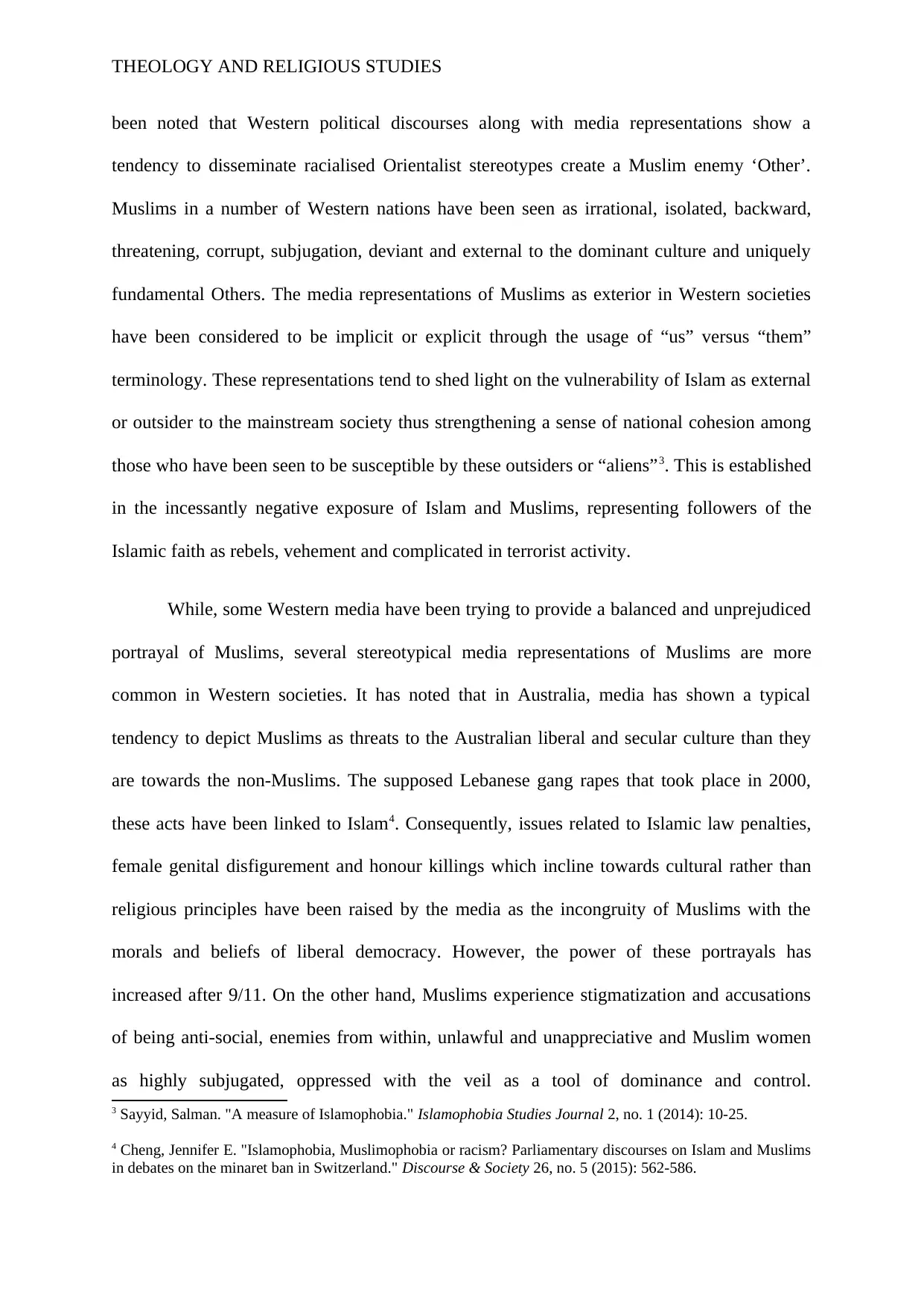
THEOLOGY AND RELIGIOUS STUDIES
been noted that Western political discourses along with media representations show a
tendency to disseminate racialised Orientalist stereotypes create a Muslim enemy ‘Other’.
Muslims in a number of Western nations have been seen as irrational, isolated, backward,
threatening, corrupt, subjugation, deviant and external to the dominant culture and uniquely
fundamental Others. The media representations of Muslims as exterior in Western societies
have been considered to be implicit or explicit through the usage of “us” versus “them”
terminology. These representations tend to shed light on the vulnerability of Islam as external
or outsider to the mainstream society thus strengthening a sense of national cohesion among
those who have been seen to be susceptible by these outsiders or “aliens”3. This is established
in the incessantly negative exposure of Islam and Muslims, representing followers of the
Islamic faith as rebels, vehement and complicated in terrorist activity.
While, some Western media have been trying to provide a balanced and unprejudiced
portrayal of Muslims, several stereotypical media representations of Muslims are more
common in Western societies. It has noted that in Australia, media has shown a typical
tendency to depict Muslims as threats to the Australian liberal and secular culture than they
are towards the non-Muslims. The supposed Lebanese gang rapes that took place in 2000,
these acts have been linked to Islam4. Consequently, issues related to Islamic law penalties,
female genital disfigurement and honour killings which incline towards cultural rather than
religious principles have been raised by the media as the incongruity of Muslims with the
morals and beliefs of liberal democracy. However, the power of these portrayals has
increased after 9/11. On the other hand, Muslims experience stigmatization and accusations
of being anti-social, enemies from within, unlawful and unappreciative and Muslim women
as highly subjugated, oppressed with the veil as a tool of dominance and control.
3 Sayyid, Salman. "A measure of Islamophobia." Islamophobia Studies Journal 2, no. 1 (2014): 10-25.
4 Cheng, Jennifer E. "Islamophobia, Muslimophobia or racism? Parliamentary discourses on Islam and Muslims
in debates on the minaret ban in Switzerland." Discourse & Society 26, no. 5 (2015): 562-586.
been noted that Western political discourses along with media representations show a
tendency to disseminate racialised Orientalist stereotypes create a Muslim enemy ‘Other’.
Muslims in a number of Western nations have been seen as irrational, isolated, backward,
threatening, corrupt, subjugation, deviant and external to the dominant culture and uniquely
fundamental Others. The media representations of Muslims as exterior in Western societies
have been considered to be implicit or explicit through the usage of “us” versus “them”
terminology. These representations tend to shed light on the vulnerability of Islam as external
or outsider to the mainstream society thus strengthening a sense of national cohesion among
those who have been seen to be susceptible by these outsiders or “aliens”3. This is established
in the incessantly negative exposure of Islam and Muslims, representing followers of the
Islamic faith as rebels, vehement and complicated in terrorist activity.
While, some Western media have been trying to provide a balanced and unprejudiced
portrayal of Muslims, several stereotypical media representations of Muslims are more
common in Western societies. It has noted that in Australia, media has shown a typical
tendency to depict Muslims as threats to the Australian liberal and secular culture than they
are towards the non-Muslims. The supposed Lebanese gang rapes that took place in 2000,
these acts have been linked to Islam4. Consequently, issues related to Islamic law penalties,
female genital disfigurement and honour killings which incline towards cultural rather than
religious principles have been raised by the media as the incongruity of Muslims with the
morals and beliefs of liberal democracy. However, the power of these portrayals has
increased after 9/11. On the other hand, Muslims experience stigmatization and accusations
of being anti-social, enemies from within, unlawful and unappreciative and Muslim women
as highly subjugated, oppressed with the veil as a tool of dominance and control.
3 Sayyid, Salman. "A measure of Islamophobia." Islamophobia Studies Journal 2, no. 1 (2014): 10-25.
4 Cheng, Jennifer E. "Islamophobia, Muslimophobia or racism? Parliamentary discourses on Islam and Muslims
in debates on the minaret ban in Switzerland." Discourse & Society 26, no. 5 (2015): 562-586.
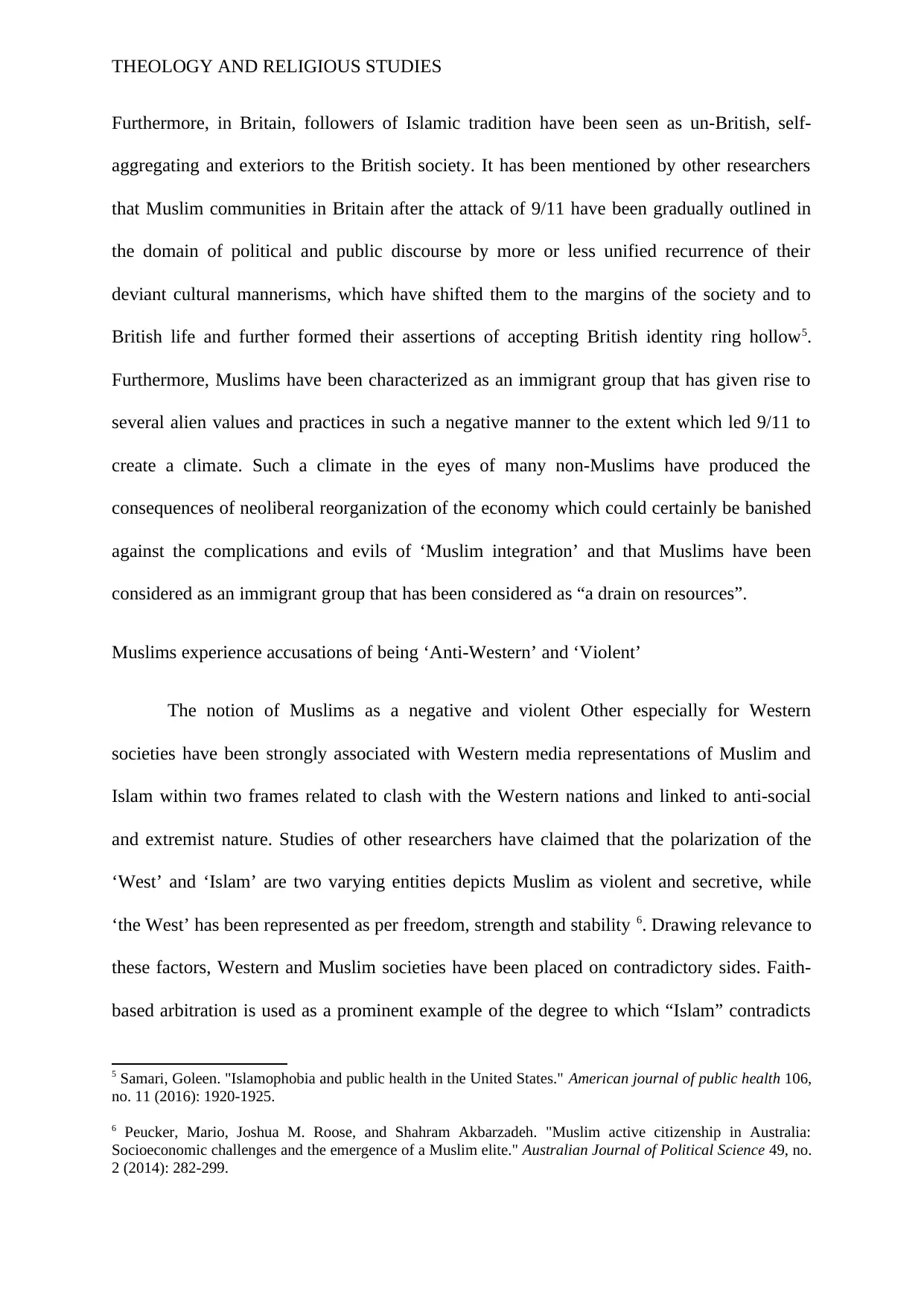
THEOLOGY AND RELIGIOUS STUDIES
Furthermore, in Britain, followers of Islamic tradition have been seen as un-British, self-
aggregating and exteriors to the British society. It has been mentioned by other researchers
that Muslim communities in Britain after the attack of 9/11 have been gradually outlined in
the domain of political and public discourse by more or less unified recurrence of their
deviant cultural mannerisms, which have shifted them to the margins of the society and to
British life and further formed their assertions of accepting British identity ring hollow5.
Furthermore, Muslims have been characterized as an immigrant group that has given rise to
several alien values and practices in such a negative manner to the extent which led 9/11 to
create a climate. Such a climate in the eyes of many non-Muslims have produced the
consequences of neoliberal reorganization of the economy which could certainly be banished
against the complications and evils of ‘Muslim integration’ and that Muslims have been
considered as an immigrant group that has been considered as “a drain on resources”.
Muslims experience accusations of being ‘Anti-Western’ and ‘Violent’
The notion of Muslims as a negative and violent Other especially for Western
societies have been strongly associated with Western media representations of Muslim and
Islam within two frames related to clash with the Western nations and linked to anti-social
and extremist nature. Studies of other researchers have claimed that the polarization of the
‘West’ and ‘Islam’ are two varying entities depicts Muslim as violent and secretive, while
‘the West’ has been represented as per freedom, strength and stability 6. Drawing relevance to
these factors, Western and Muslim societies have been placed on contradictory sides. Faith-
based arbitration is used as a prominent example of the degree to which “Islam” contradicts
5 Samari, Goleen. "Islamophobia and public health in the United States." American journal of public health 106,
no. 11 (2016): 1920-1925.
6 Peucker, Mario, Joshua M. Roose, and Shahram Akbarzadeh. "Muslim active citizenship in Australia:
Socioeconomic challenges and the emergence of a Muslim elite." Australian Journal of Political Science 49, no.
2 (2014): 282-299.
Furthermore, in Britain, followers of Islamic tradition have been seen as un-British, self-
aggregating and exteriors to the British society. It has been mentioned by other researchers
that Muslim communities in Britain after the attack of 9/11 have been gradually outlined in
the domain of political and public discourse by more or less unified recurrence of their
deviant cultural mannerisms, which have shifted them to the margins of the society and to
British life and further formed their assertions of accepting British identity ring hollow5.
Furthermore, Muslims have been characterized as an immigrant group that has given rise to
several alien values and practices in such a negative manner to the extent which led 9/11 to
create a climate. Such a climate in the eyes of many non-Muslims have produced the
consequences of neoliberal reorganization of the economy which could certainly be banished
against the complications and evils of ‘Muslim integration’ and that Muslims have been
considered as an immigrant group that has been considered as “a drain on resources”.
Muslims experience accusations of being ‘Anti-Western’ and ‘Violent’
The notion of Muslims as a negative and violent Other especially for Western
societies have been strongly associated with Western media representations of Muslim and
Islam within two frames related to clash with the Western nations and linked to anti-social
and extremist nature. Studies of other researchers have claimed that the polarization of the
‘West’ and ‘Islam’ are two varying entities depicts Muslim as violent and secretive, while
‘the West’ has been represented as per freedom, strength and stability 6. Drawing relevance to
these factors, Western and Muslim societies have been placed on contradictory sides. Faith-
based arbitration is used as a prominent example of the degree to which “Islam” contradicts
5 Samari, Goleen. "Islamophobia and public health in the United States." American journal of public health 106,
no. 11 (2016): 1920-1925.
6 Peucker, Mario, Joshua M. Roose, and Shahram Akbarzadeh. "Muslim active citizenship in Australia:
Socioeconomic challenges and the emergence of a Muslim elite." Australian Journal of Political Science 49, no.
2 (2014): 282-299.
Secure Best Marks with AI Grader
Need help grading? Try our AI Grader for instant feedback on your assignments.
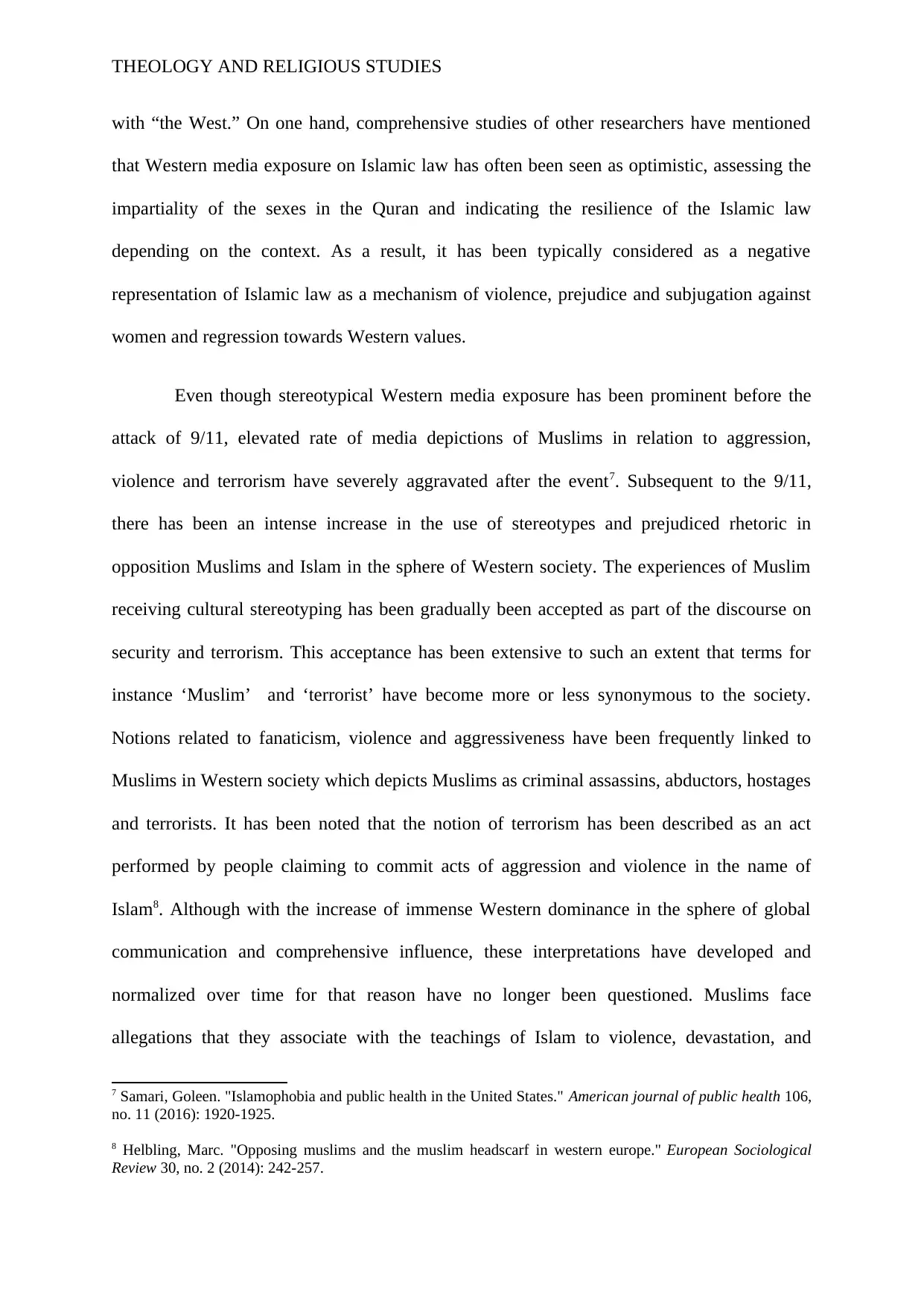
THEOLOGY AND RELIGIOUS STUDIES
with “the West.” On one hand, comprehensive studies of other researchers have mentioned
that Western media exposure on Islamic law has often been seen as optimistic, assessing the
impartiality of the sexes in the Quran and indicating the resilience of the Islamic law
depending on the context. As a result, it has been typically considered as a negative
representation of Islamic law as a mechanism of violence, prejudice and subjugation against
women and regression towards Western values.
Even though stereotypical Western media exposure has been prominent before the
attack of 9/11, elevated rate of media depictions of Muslims in relation to aggression,
violence and terrorism have severely aggravated after the event7. Subsequent to the 9/11,
there has been an intense increase in the use of stereotypes and prejudiced rhetoric in
opposition Muslims and Islam in the sphere of Western society. The experiences of Muslim
receiving cultural stereotyping has been gradually been accepted as part of the discourse on
security and terrorism. This acceptance has been extensive to such an extent that terms for
instance ‘Muslim’ and ‘terrorist’ have become more or less synonymous to the society.
Notions related to fanaticism, violence and aggressiveness have been frequently linked to
Muslims in Western society which depicts Muslims as criminal assassins, abductors, hostages
and terrorists. It has been noted that the notion of terrorism has been described as an act
performed by people claiming to commit acts of aggression and violence in the name of
Islam8. Although with the increase of immense Western dominance in the sphere of global
communication and comprehensive influence, these interpretations have developed and
normalized over time for that reason have no longer been questioned. Muslims face
allegations that they associate with the teachings of Islam to violence, devastation, and
7 Samari, Goleen. "Islamophobia and public health in the United States." American journal of public health 106,
no. 11 (2016): 1920-1925.
8 Helbling, Marc. "Opposing muslims and the muslim headscarf in western europe." European Sociological
Review 30, no. 2 (2014): 242-257.
with “the West.” On one hand, comprehensive studies of other researchers have mentioned
that Western media exposure on Islamic law has often been seen as optimistic, assessing the
impartiality of the sexes in the Quran and indicating the resilience of the Islamic law
depending on the context. As a result, it has been typically considered as a negative
representation of Islamic law as a mechanism of violence, prejudice and subjugation against
women and regression towards Western values.
Even though stereotypical Western media exposure has been prominent before the
attack of 9/11, elevated rate of media depictions of Muslims in relation to aggression,
violence and terrorism have severely aggravated after the event7. Subsequent to the 9/11,
there has been an intense increase in the use of stereotypes and prejudiced rhetoric in
opposition Muslims and Islam in the sphere of Western society. The experiences of Muslim
receiving cultural stereotyping has been gradually been accepted as part of the discourse on
security and terrorism. This acceptance has been extensive to such an extent that terms for
instance ‘Muslim’ and ‘terrorist’ have become more or less synonymous to the society.
Notions related to fanaticism, violence and aggressiveness have been frequently linked to
Muslims in Western society which depicts Muslims as criminal assassins, abductors, hostages
and terrorists. It has been noted that the notion of terrorism has been described as an act
performed by people claiming to commit acts of aggression and violence in the name of
Islam8. Although with the increase of immense Western dominance in the sphere of global
communication and comprehensive influence, these interpretations have developed and
normalized over time for that reason have no longer been questioned. Muslims face
allegations that they associate with the teachings of Islam to violence, devastation, and
7 Samari, Goleen. "Islamophobia and public health in the United States." American journal of public health 106,
no. 11 (2016): 1920-1925.
8 Helbling, Marc. "Opposing muslims and the muslim headscarf in western europe." European Sociological
Review 30, no. 2 (2014): 242-257.
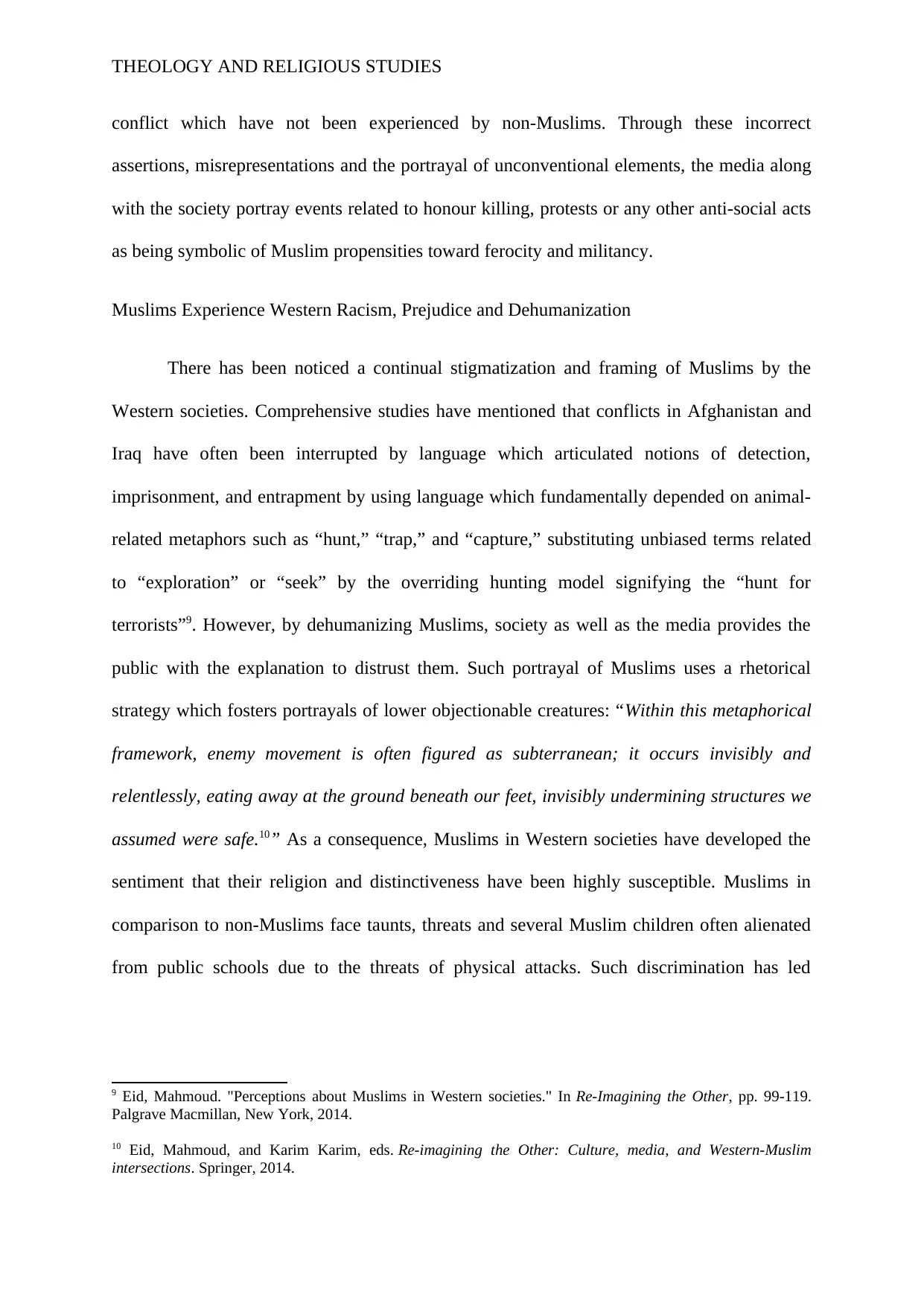
THEOLOGY AND RELIGIOUS STUDIES
conflict which have not been experienced by non-Muslims. Through these incorrect
assertions, misrepresentations and the portrayal of unconventional elements, the media along
with the society portray events related to honour killing, protests or any other anti-social acts
as being symbolic of Muslim propensities toward ferocity and militancy.
Muslims Experience Western Racism, Prejudice and Dehumanization
There has been noticed a continual stigmatization and framing of Muslims by the
Western societies. Comprehensive studies have mentioned that conflicts in Afghanistan and
Iraq have often been interrupted by language which articulated notions of detection,
imprisonment, and entrapment by using language which fundamentally depended on animal-
related metaphors such as “hunt,” “trap,” and “capture,” substituting unbiased terms related
to “exploration” or “seek” by the overriding hunting model signifying the “hunt for
terrorists”9. However, by dehumanizing Muslims, society as well as the media provides the
public with the explanation to distrust them. Such portrayal of Muslims uses a rhetorical
strategy which fosters portrayals of lower objectionable creatures: “Within this metaphorical
framework, enemy movement is often figured as subterranean; it occurs invisibly and
relentlessly, eating away at the ground beneath our feet, invisibly undermining structures we
assumed were safe.10” As a consequence, Muslims in Western societies have developed the
sentiment that their religion and distinctiveness have been highly susceptible. Muslims in
comparison to non-Muslims face taunts, threats and several Muslim children often alienated
from public schools due to the threats of physical attacks. Such discrimination has led
9 Eid, Mahmoud. "Perceptions about Muslims in Western societies." In Re-Imagining the Other, pp. 99-119.
Palgrave Macmillan, New York, 2014.
10 Eid, Mahmoud, and Karim Karim, eds. Re-imagining the Other: Culture, media, and Western-Muslim
intersections. Springer, 2014.
conflict which have not been experienced by non-Muslims. Through these incorrect
assertions, misrepresentations and the portrayal of unconventional elements, the media along
with the society portray events related to honour killing, protests or any other anti-social acts
as being symbolic of Muslim propensities toward ferocity and militancy.
Muslims Experience Western Racism, Prejudice and Dehumanization
There has been noticed a continual stigmatization and framing of Muslims by the
Western societies. Comprehensive studies have mentioned that conflicts in Afghanistan and
Iraq have often been interrupted by language which articulated notions of detection,
imprisonment, and entrapment by using language which fundamentally depended on animal-
related metaphors such as “hunt,” “trap,” and “capture,” substituting unbiased terms related
to “exploration” or “seek” by the overriding hunting model signifying the “hunt for
terrorists”9. However, by dehumanizing Muslims, society as well as the media provides the
public with the explanation to distrust them. Such portrayal of Muslims uses a rhetorical
strategy which fosters portrayals of lower objectionable creatures: “Within this metaphorical
framework, enemy movement is often figured as subterranean; it occurs invisibly and
relentlessly, eating away at the ground beneath our feet, invisibly undermining structures we
assumed were safe.10” As a consequence, Muslims in Western societies have developed the
sentiment that their religion and distinctiveness have been highly susceptible. Muslims in
comparison to non-Muslims face taunts, threats and several Muslim children often alienated
from public schools due to the threats of physical attacks. Such discrimination has led
9 Eid, Mahmoud. "Perceptions about Muslims in Western societies." In Re-Imagining the Other, pp. 99-119.
Palgrave Macmillan, New York, 2014.
10 Eid, Mahmoud, and Karim Karim, eds. Re-imagining the Other: Culture, media, and Western-Muslim
intersections. Springer, 2014.
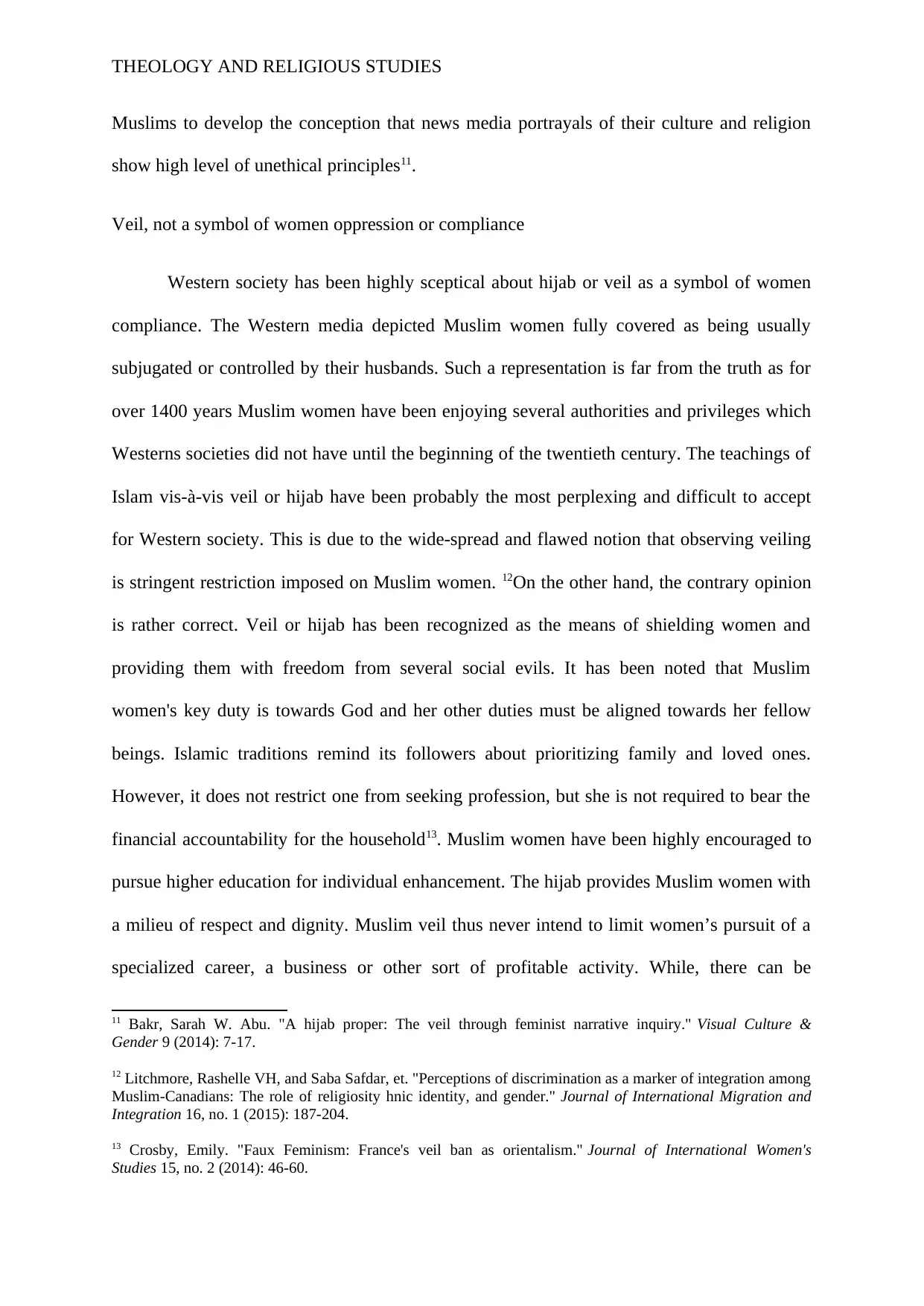
THEOLOGY AND RELIGIOUS STUDIES
Muslims to develop the conception that news media portrayals of their culture and religion
show high level of unethical principles11.
Veil, not a symbol of women oppression or compliance
Western society has been highly sceptical about hijab or veil as a symbol of women
compliance. The Western media depicted Muslim women fully covered as being usually
subjugated or controlled by their husbands. Such a representation is far from the truth as for
over 1400 years Muslim women have been enjoying several authorities and privileges which
Westerns societies did not have until the beginning of the twentieth century. The teachings of
Islam vis-à-vis veil or hijab have been probably the most perplexing and difficult to accept
for Western society. This is due to the wide-spread and flawed notion that observing veiling
is stringent restriction imposed on Muslim women. 12On the other hand, the contrary opinion
is rather correct. Veil or hijab has been recognized as the means of shielding women and
providing them with freedom from several social evils. It has been noted that Muslim
women's key duty is towards God and her other duties must be aligned towards her fellow
beings. Islamic traditions remind its followers about prioritizing family and loved ones.
However, it does not restrict one from seeking profession, but she is not required to bear the
financial accountability for the household13. Muslim women have been highly encouraged to
pursue higher education for individual enhancement. The hijab provides Muslim women with
a milieu of respect and dignity. Muslim veil thus never intend to limit women’s pursuit of a
specialized career, a business or other sort of profitable activity. While, there can be
11 Bakr, Sarah W. Abu. "A hijab proper: The veil through feminist narrative inquiry." Visual Culture &
Gender 9 (2014): 7-17.
12 Litchmore, Rashelle VH, and Saba Safdar, et. "Perceptions of discrimination as a marker of integration among
Muslim-Canadians: The role of religiosity hnic identity, and gender." Journal of International Migration and
Integration 16, no. 1 (2015): 187-204.
13 Crosby, Emily. "Faux Feminism: France's veil ban as orientalism." Journal of International Women's
Studies 15, no. 2 (2014): 46-60.
Muslims to develop the conception that news media portrayals of their culture and religion
show high level of unethical principles11.
Veil, not a symbol of women oppression or compliance
Western society has been highly sceptical about hijab or veil as a symbol of women
compliance. The Western media depicted Muslim women fully covered as being usually
subjugated or controlled by their husbands. Such a representation is far from the truth as for
over 1400 years Muslim women have been enjoying several authorities and privileges which
Westerns societies did not have until the beginning of the twentieth century. The teachings of
Islam vis-à-vis veil or hijab have been probably the most perplexing and difficult to accept
for Western society. This is due to the wide-spread and flawed notion that observing veiling
is stringent restriction imposed on Muslim women. 12On the other hand, the contrary opinion
is rather correct. Veil or hijab has been recognized as the means of shielding women and
providing them with freedom from several social evils. It has been noted that Muslim
women's key duty is towards God and her other duties must be aligned towards her fellow
beings. Islamic traditions remind its followers about prioritizing family and loved ones.
However, it does not restrict one from seeking profession, but she is not required to bear the
financial accountability for the household13. Muslim women have been highly encouraged to
pursue higher education for individual enhancement. The hijab provides Muslim women with
a milieu of respect and dignity. Muslim veil thus never intend to limit women’s pursuit of a
specialized career, a business or other sort of profitable activity. While, there can be
11 Bakr, Sarah W. Abu. "A hijab proper: The veil through feminist narrative inquiry." Visual Culture &
Gender 9 (2014): 7-17.
12 Litchmore, Rashelle VH, and Saba Safdar, et. "Perceptions of discrimination as a marker of integration among
Muslim-Canadians: The role of religiosity hnic identity, and gender." Journal of International Migration and
Integration 16, no. 1 (2015): 187-204.
13 Crosby, Emily. "Faux Feminism: France's veil ban as orientalism." Journal of International Women's
Studies 15, no. 2 (2014): 46-60.
Paraphrase This Document
Need a fresh take? Get an instant paraphrase of this document with our AI Paraphraser
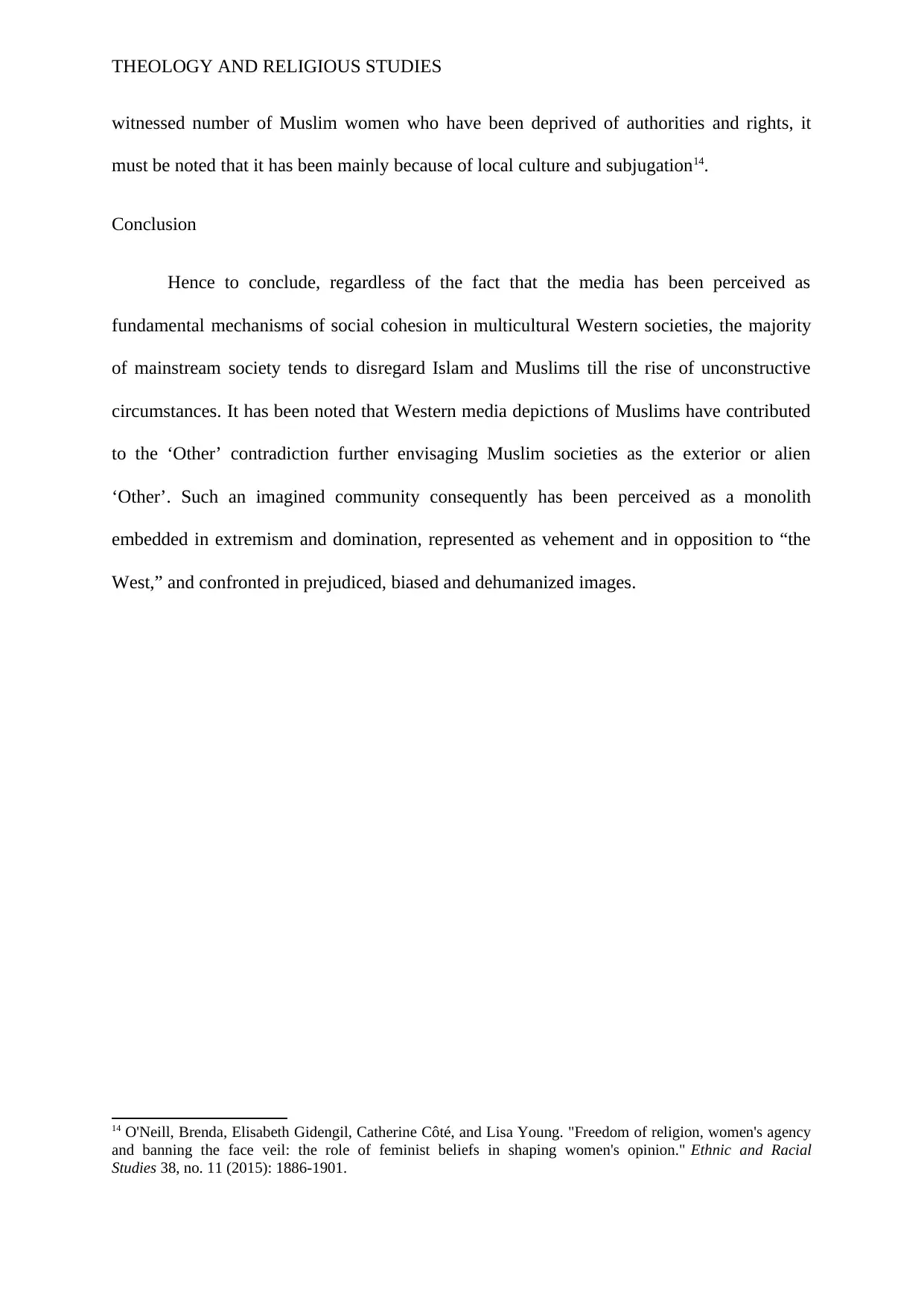
THEOLOGY AND RELIGIOUS STUDIES
witnessed number of Muslim women who have been deprived of authorities and rights, it
must be noted that it has been mainly because of local culture and subjugation14.
Conclusion
Hence to conclude, regardless of the fact that the media has been perceived as
fundamental mechanisms of social cohesion in multicultural Western societies, the majority
of mainstream society tends to disregard Islam and Muslims till the rise of unconstructive
circumstances. It has been noted that Western media depictions of Muslims have contributed
to the ‘Other’ contradiction further envisaging Muslim societies as the exterior or alien
‘Other’. Such an imagined community consequently has been perceived as a monolith
embedded in extremism and domination, represented as vehement and in opposition to “the
West,” and confronted in prejudiced, biased and dehumanized images.
14 O'Neill, Brenda, Elisabeth Gidengil, Catherine Côté, and Lisa Young. "Freedom of religion, women's agency
and banning the face veil: the role of feminist beliefs in shaping women's opinion." Ethnic and Racial
Studies 38, no. 11 (2015): 1886-1901.
witnessed number of Muslim women who have been deprived of authorities and rights, it
must be noted that it has been mainly because of local culture and subjugation14.
Conclusion
Hence to conclude, regardless of the fact that the media has been perceived as
fundamental mechanisms of social cohesion in multicultural Western societies, the majority
of mainstream society tends to disregard Islam and Muslims till the rise of unconstructive
circumstances. It has been noted that Western media depictions of Muslims have contributed
to the ‘Other’ contradiction further envisaging Muslim societies as the exterior or alien
‘Other’. Such an imagined community consequently has been perceived as a monolith
embedded in extremism and domination, represented as vehement and in opposition to “the
West,” and confronted in prejudiced, biased and dehumanized images.
14 O'Neill, Brenda, Elisabeth Gidengil, Catherine Côté, and Lisa Young. "Freedom of religion, women's agency
and banning the face veil: the role of feminist beliefs in shaping women's opinion." Ethnic and Racial
Studies 38, no. 11 (2015): 1886-1901.
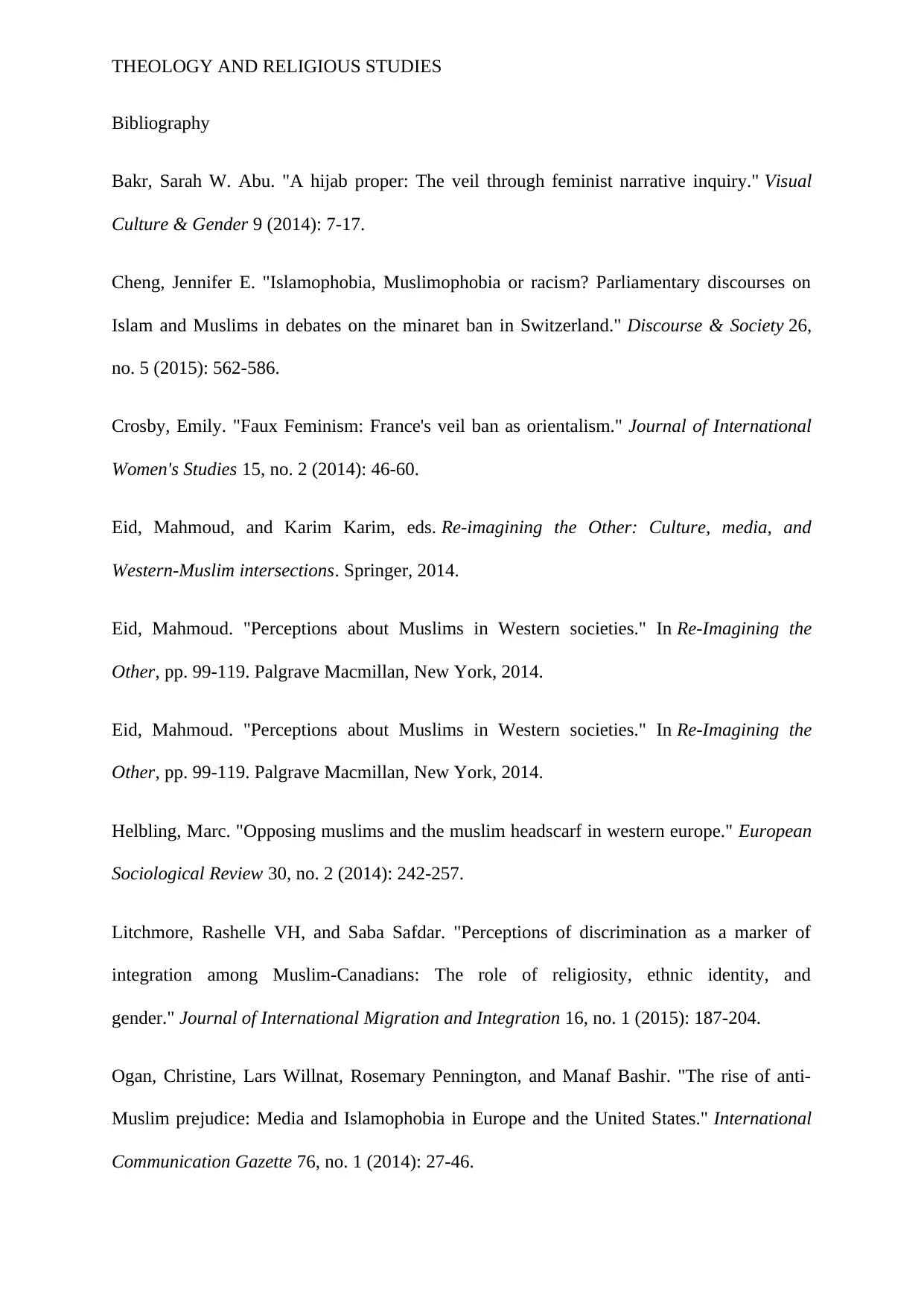
THEOLOGY AND RELIGIOUS STUDIES
Bibliography
Bakr, Sarah W. Abu. "A hijab proper: The veil through feminist narrative inquiry." Visual
Culture & Gender 9 (2014): 7-17.
Cheng, Jennifer E. "Islamophobia, Muslimophobia or racism? Parliamentary discourses on
Islam and Muslims in debates on the minaret ban in Switzerland." Discourse & Society 26,
no. 5 (2015): 562-586.
Crosby, Emily. "Faux Feminism: France's veil ban as orientalism." Journal of International
Women's Studies 15, no. 2 (2014): 46-60.
Eid, Mahmoud, and Karim Karim, eds. Re-imagining the Other: Culture, media, and
Western-Muslim intersections. Springer, 2014.
Eid, Mahmoud. "Perceptions about Muslims in Western societies." In Re-Imagining the
Other, pp. 99-119. Palgrave Macmillan, New York, 2014.
Eid, Mahmoud. "Perceptions about Muslims in Western societies." In Re-Imagining the
Other, pp. 99-119. Palgrave Macmillan, New York, 2014.
Helbling, Marc. "Opposing muslims and the muslim headscarf in western europe." European
Sociological Review 30, no. 2 (2014): 242-257.
Litchmore, Rashelle VH, and Saba Safdar. "Perceptions of discrimination as a marker of
integration among Muslim-Canadians: The role of religiosity, ethnic identity, and
gender." Journal of International Migration and Integration 16, no. 1 (2015): 187-204.
Ogan, Christine, Lars Willnat, Rosemary Pennington, and Manaf Bashir. "The rise of anti-
Muslim prejudice: Media and Islamophobia in Europe and the United States." International
Communication Gazette 76, no. 1 (2014): 27-46.
Bibliography
Bakr, Sarah W. Abu. "A hijab proper: The veil through feminist narrative inquiry." Visual
Culture & Gender 9 (2014): 7-17.
Cheng, Jennifer E. "Islamophobia, Muslimophobia or racism? Parliamentary discourses on
Islam and Muslims in debates on the minaret ban in Switzerland." Discourse & Society 26,
no. 5 (2015): 562-586.
Crosby, Emily. "Faux Feminism: France's veil ban as orientalism." Journal of International
Women's Studies 15, no. 2 (2014): 46-60.
Eid, Mahmoud, and Karim Karim, eds. Re-imagining the Other: Culture, media, and
Western-Muslim intersections. Springer, 2014.
Eid, Mahmoud. "Perceptions about Muslims in Western societies." In Re-Imagining the
Other, pp. 99-119. Palgrave Macmillan, New York, 2014.
Eid, Mahmoud. "Perceptions about Muslims in Western societies." In Re-Imagining the
Other, pp. 99-119. Palgrave Macmillan, New York, 2014.
Helbling, Marc. "Opposing muslims and the muslim headscarf in western europe." European
Sociological Review 30, no. 2 (2014): 242-257.
Litchmore, Rashelle VH, and Saba Safdar. "Perceptions of discrimination as a marker of
integration among Muslim-Canadians: The role of religiosity, ethnic identity, and
gender." Journal of International Migration and Integration 16, no. 1 (2015): 187-204.
Ogan, Christine, Lars Willnat, Rosemary Pennington, and Manaf Bashir. "The rise of anti-
Muslim prejudice: Media and Islamophobia in Europe and the United States." International
Communication Gazette 76, no. 1 (2014): 27-46.
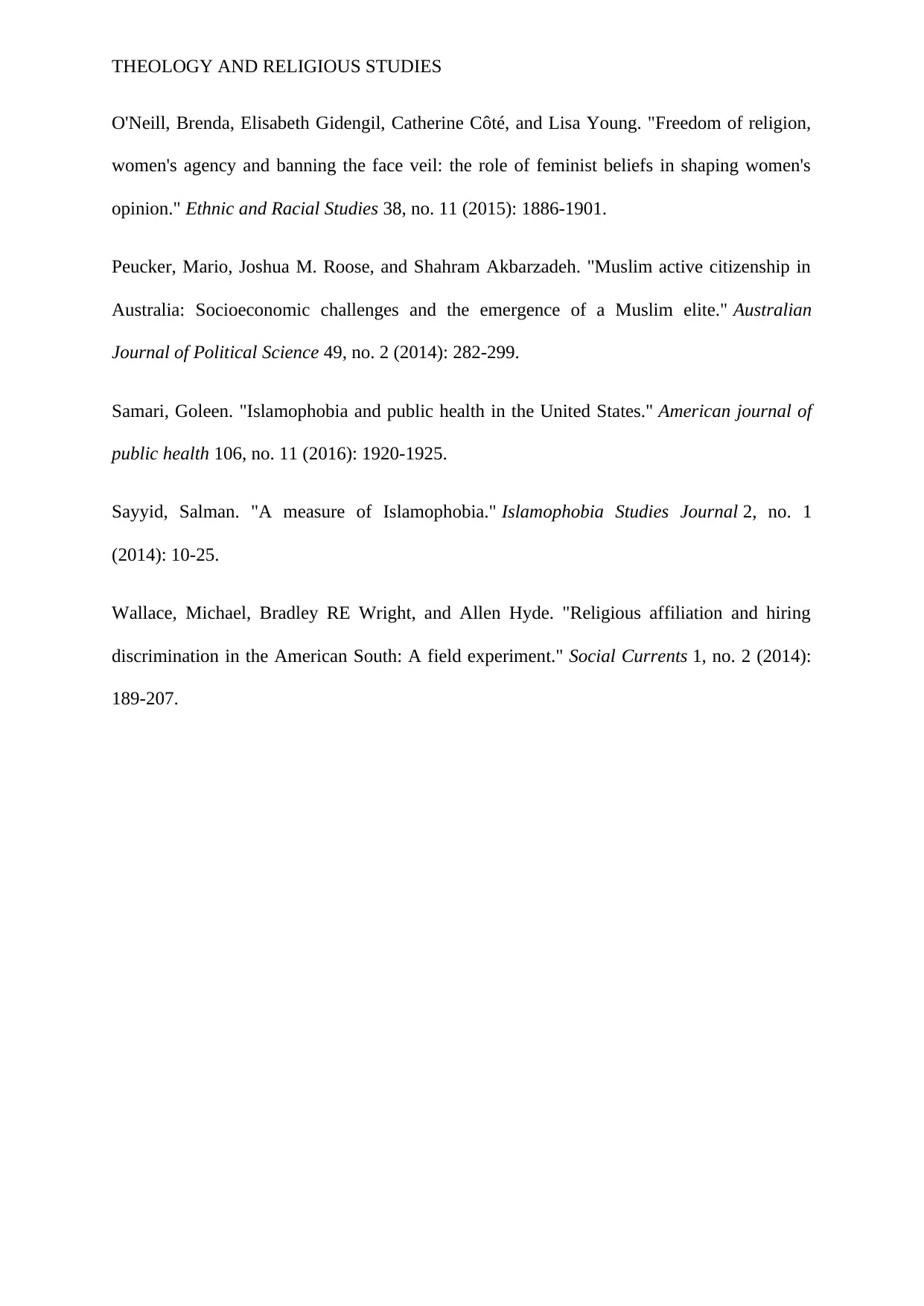
THEOLOGY AND RELIGIOUS STUDIES
O'Neill, Brenda, Elisabeth Gidengil, Catherine Côté, and Lisa Young. "Freedom of religion,
women's agency and banning the face veil: the role of feminist beliefs in shaping women's
opinion." Ethnic and Racial Studies 38, no. 11 (2015): 1886-1901.
Peucker, Mario, Joshua M. Roose, and Shahram Akbarzadeh. "Muslim active citizenship in
Australia: Socioeconomic challenges and the emergence of a Muslim elite." Australian
Journal of Political Science 49, no. 2 (2014): 282-299.
Samari, Goleen. "Islamophobia and public health in the United States." American journal of
public health 106, no. 11 (2016): 1920-1925.
Sayyid, Salman. "A measure of Islamophobia." Islamophobia Studies Journal 2, no. 1
(2014): 10-25.
Wallace, Michael, Bradley RE Wright, and Allen Hyde. "Religious affiliation and hiring
discrimination in the American South: A field experiment." Social Currents 1, no. 2 (2014):
189-207.
O'Neill, Brenda, Elisabeth Gidengil, Catherine Côté, and Lisa Young. "Freedom of religion,
women's agency and banning the face veil: the role of feminist beliefs in shaping women's
opinion." Ethnic and Racial Studies 38, no. 11 (2015): 1886-1901.
Peucker, Mario, Joshua M. Roose, and Shahram Akbarzadeh. "Muslim active citizenship in
Australia: Socioeconomic challenges and the emergence of a Muslim elite." Australian
Journal of Political Science 49, no. 2 (2014): 282-299.
Samari, Goleen. "Islamophobia and public health in the United States." American journal of
public health 106, no. 11 (2016): 1920-1925.
Sayyid, Salman. "A measure of Islamophobia." Islamophobia Studies Journal 2, no. 1
(2014): 10-25.
Wallace, Michael, Bradley RE Wright, and Allen Hyde. "Religious affiliation and hiring
discrimination in the American South: A field experiment." Social Currents 1, no. 2 (2014):
189-207.
1 out of 10
Your All-in-One AI-Powered Toolkit for Academic Success.
+13062052269
info@desklib.com
Available 24*7 on WhatsApp / Email
![[object Object]](/_next/static/media/star-bottom.7253800d.svg)
Unlock your academic potential
© 2024 | Zucol Services PVT LTD | All rights reserved.


